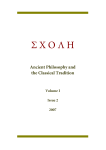Статьи журнала - Schole. Философское антиковедение и классическая традиция
Все статьи: 593
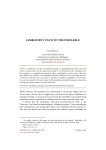
Iamblichus path to the ineffable
Статья научная
Iamblichus of Chalcis postulated theurgy on metaphysical grounds as the only means of communion with the supreme principle of everything that exists. Iamblichus sets this principle as a completely transcendent reality, unattainable by reason, and, at the same time, differs from Plotinus, who postulated absolute withdrawal from everything and conceived union with the One as an escape in solitude to the solitary. Iamblichus conceives matter as an instrument for the souls ascent to that principle and explicitly proposes a mysticism of solidarity with the cosmos and with other souls.
Бесплатно
Iconography of Plato in antiquity and in medieval orthodox painting
Статья научная
The article is devoted to the topic of visualization, which is relevant for the modern world in general and scientific knowledge in particular, investigated through the image of Plato in Antiquity and in medieval Orthodox painting. Using the example of Plato’s iconography as a visual message, the authors want to show the great potential for the development of the visual history of philosophy, anthropology and culture in general, as well as the new visually oriented semiotics and semantics of the image. This approach reveals expressively and meaningfully its relevance for the study of Plato’s image, together with other ancient philosophers’ images, in Orthodox medieval churches in Greece, Serbia, Romania, Bulgaria and, of course, ancient Russia in the 15th-17th cc, allowing to see the great ancient Greek philosopher from a new perspective.
Бесплатно
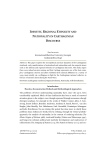
Identity, regional ethnicity and nationality in Carthaginian discourse
Статья научная
This paper explores the sociopolitical and state dynamics of the Carthaginian statehood, early manifestations of nationhood and nationalism and also unpacks issues such as the identity and regional ethnicity in Carthaginian discourse. This study argues there were indeed ancient nations and that Carthage represents one of the best examples. Carthaginian citizens and allies exhibited their national affiliation in a variety of ways, most notably via a willingness to fight for the Carthaginian national collective in the face of extreme duress during the Punic Wars.
Бесплатно
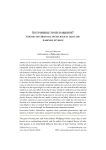
Is it possible to see darkness? Goethe and Aristotle on the role of light and darkness in vision
Статья научная
J.W. Goethe in his Farbenlehre deduced all physical colors from a simple primordial phenomenon that takes place every time light and darkness act through a semi-transparent colorless medium either on our eyes or on the opposite surfaces. This basic rule of Goethe’s color theory was criticized by his contemporary physicists, who argued that darkness could not play an active role in the origin of colors because of being a mere absence of light. The paper demonstrates that this criticism became possible only if one shares the Newtonian view on the nature of light and darkness. Goethe however held a more traditional point of view, which he traced back to Antiquity and Aristotle. In contrast to Newton and his followers, previous scientists considered light not as an immediate cause of colors but as an actually transparent medium that conveyed colors from the visible objects to the organ of sight. For vision to take place, the color must first affect the light, which in its turn, must affect the faculty of vision. Though it is difficult to say what kind of change the light undergoes when some colored object is seen through it, most Aristotle commentators agree that this change must be real and not mere relational. In Aristotle’s physics, however, things that are capable of acting on and being affected by one another are either contraries or consist of contraries. Therefore, to be visible the color must be either dark or to contain darkness. Thus, assuming that Goethe shared the Aristotelian concept of light, we have to conclude that he was not mistaken saying that darkness "acts” upon our eyes or “is seen through” the illuminated semi-transparent medium.
Бесплатно
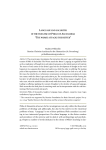
Language and laughter in the treatise of Philo of Alexandria “The Worse attacks the Better”
Статья научная
The present paper investigates the interaction between Logos and language in the treatise of Philo of Alexandria "The Worse attacks the Better". Language is regarded by Philo as the actualization of thought in its articulated expression, as the initial moment of creativity. The source of such action is the divine Logos, but the development of thought in the word happens in two opposite directions: one leads to joy, while the other, to suffering. The starting point of this separation is the initial orientation (love) of the mind to God or to self. In the first case, the mind in the act of utterance (expression) overcomes its own isolation. It comes into contact with the divine Logos and achieves joy. The crucial moment of this "leaving the brackets" of self individual thinking towards the light of the divine Logos is laughter. In another case, when the mind does not link words with their source, false creativity is produced, leading to suffering. Аpplying the concept of laughter to the doctrine of Logos and language, Philo reconciles the ideal plan of conceiving truth and its interpretation with the real functioning of the human mind and speech.
Бесплатно
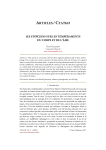
Les sto"iciens sur les temp'eraments du corps et de l’^ame
Статья научная
This article is concerned with the often neglected physical side of Stoic anthropology. The care for one’s soul is central to the Stoic notion of the art of living. Yet a special status is reserved for the human body—in spite of its being subsumed under the class of (preferred) ‘indifferents’. This status is explicable by reference to the fact that they regard the soul as a subtle kind of breath ( pneuma ) and hence as corporeal. As such, it is blended with the human body through and through. Care for the soul therefore involves care for the body. Furthermore, the Stoic view of the human organism entails a special interest in physiognomy. These interrelated aspects are studied against the backdrop of the relevant medical theories used by the Stoics.
Бесплатно
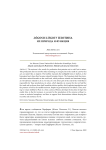
Logos и logoi у плотина: их природа и функция
Статья научная
Космос возникает не в результате деятельности творца, но согласно природе. Это возникновение не предполагает мышления или концептуализации, но является результатом действия силы, которая запечатлевает себя в материи. Ум сообщает умопостигаемые формы, которые в нем содержатся, гипостазированной Душе, в которой они превращаются в рациональные формулы (logoi). Затем Душа передает эти рациональные формулы мировой душе, которая порождает одушевленные и неодушевленные сущности, словно по указанию, полученному свыше. Однако, поскольку за порождение ответственна низшая часть мировой души, которая действует по своему разумению, возникшие в результате сущности уступают по качеству своему образцу, что объясняет несовершенство чувственно воспринимаемого космоса и наличие зла, несмотря на присутствующую в нем направляющую силу Промысла.
Бесплатно
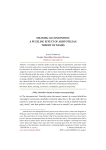
Meaning as convention: a puzzling effect of Aristotelian theory of names
Статья научная
According to Aristotle spoken words are signs of impressions, and those words which are used as names have conventional meanings. This theory of meaning poses a problem because it is unclear how exactly impressions which are essentially subjective may be assigned to names conventionally, i.e. due to certain interactions between different persons. In the following article the nature of the problem as well as the most prominent notions of conventions are analyzed: it is shown that considering the ways by which conventions about meanings should be established according to them the problem cannot be eliminated. It is also claimed that this is the problem not only for the particular Aristotle's theory of names, but also a problem for a much wider set of theories of meaning and interpretation.
Бесплатно
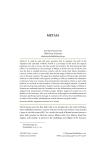
Статья научная
It could be said with some precision, that in Antiquity the myth of the Argonauts and especially of Medea herself as a personage of this myth, has enjoyed popularity not only in Greece but also outside its territories. The first among the Italic tribes to be introduced to the personage of Medea no doubt were the Etruscans, who were the first to establish intensive contacts with the Greeks from Euboea founding a colony in Cumae, Italy. It is noteworthy that the first image of Medea in the World Art is seen on Etruscan ceramics. The paper gives detailed analyses of Etruscan olpe and other artefacts on which Medea early appears, providing a solid precondition for substantive conclusions. Some new versions of an interpretation expressed in relation to each of the artefacts on the basis of critical analysis of Etruscan archeological material, of classical texts and of previously undertaken modern research, are provided. Images of Medea in Etruscan art confirmed from the Orientalist era to the Hellenization period represent an original, local interpretation of Medea's image. Medea's magical art turned out to be familiar to the Etruscans, who were well known all throughout the Mediterranean for divination and being experts of magic. In contrast to the Greeks, they turned Medea into an object of cult worship, identifying her with the Etruscan sun god Cavatha.
Бесплатно
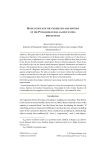
Modulation and the underlying assumptions of the pythagorean ban against eating broad beans
Статья научная
This paper tries to show that the theory of mental models describes deep mental processes that have to be assumed even by frameworks contrary to it. It has been argued that many explanations on certain cognitive activities different from that provided by the theory of mental models cannot ignore theses of this last approach. Those theses are related to the way the human mind interprets linguistic information and makes inferences. The main goal here is to give further evidence in this way by means of an analysis of a part of a fragment, authored by Diogenes Laërtius, about the Pythagorean ban against eating broad beans. The idea is to make it even more evident that any framework trying to account for how that part of the fragment can be understood by a reader needs to accept suppositions that characterize the theory of mental models.
Бесплатно
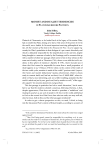
Monist and dualist tendencies in Platonism before Plotinus
Статья научная
The article by John Dillon (Trinity College, Dublin) is devoted to an interesting page in the history of adventure ideas. It traces the path made by metaphysics of the platonic sense from the "moderate monism" of Plato and the Ancient Academy, through the dualism of Plutarch and Noumenia, to the monistic position of Plotinus. Rus. trans. of this article, see ΣΧΟΛΗ ΙΙ. 1 (2008) 11-20.
Бесплатно
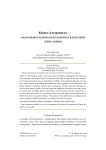
Moses Attikidzon: философия и религиозная политика в античной Александрии
Статья научная
“Библейское происхождение” основных идей эллинской философии. Эта идея, возможно, странная для современного читателя, была практически общепринятой в первые века нашей эры и восходит, по крайней мере, к Аристобулу и Филону Александрийскому. Одним из основных протагонистов этой концепции, действительно очень полезной для оправдания философии и обоснования правомерности включения ее в иудейско-христианское мироучение, следует считать Климента Александрийского, который не сомневается в том простом факте, что греческие мудрецы или позаимствовали свои учения непосредственно от самого Моисея и иудейских служителей, или же получили его свыше как откровение истинного Бога, которое поэтому не должно отличаться от закона, данного Моисею. Статья дополняется подборкой источников, иллюстрирующих историю перевода Библии на греческий язык.
Бесплатно
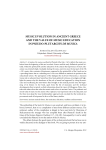
Music evolution in ancient Greece and the value of music education in pseudo-Plutarch's "De Musica"
Статья научная
A treatise De musica, ascribed to Plutarch (the 2nd c. AD), reflects the music evolution from the beginning of this art in archaic Greece until the early Hellenistic period. Initially, within the spiritual life and the education of the citizens the importance of music education was extremely high. Gradually, during the years, and even since the last part of the 5th c. BC, music, after centuries of dominance, appeared in the spiritual life of the Greeks not as a prevailing feature but as a subsiding one. It was even difficult to maintain its position in the educational system. The participants of the dialogue (the rich host Onesicrates, a musician Lysias and an educated man Soterichus) have been gathered to discuss, investigate and highlight the reasons why this decadence of the role of music has happened, by citing the musicians and recollecting the innovations they brought in the musical practise since the beginning of its history. In the book, apart from the list of musicians and the technical developments they invented, we find information about the views of Pythagoras, Plato, Aristotle and others about the value that music used to have in ancient Greece. The paideutic and moral value of music was the reason why it played a very important role in the education and the three men adopt the most traditionalistic approach and conclude that the technical improvements made it lost ground in favor of the literary studies.
Бесплатно
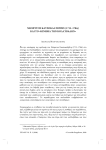
Neophytos Kausokalybites (1713-1784?) kai to "Kinema ton kollybadon"
Статья научная
Leonidas Bargeliotis (Athens) presents the essay "The Neofit Kafsokalivit (1713-1784?) And the movement of the collovads." As you know, this movement arose among the monks of Mount Athos who stood up for the protection of church customs and against those members of the "brethren" who wanted to earn money by selling their goods on the Saturday market and increasing the number of memorial services paid for by parishioners, agreeing to spend them on Sunday and holiday days. The neophyte was one of the protagonists of this movement, and to evaluate his role, the author of this article (1) gives an outline of the philosophical and theological conflicts of that time, (2) explores the religious rhetoric that accompanies the conviction of the monk Neophyte and his stubborn self-defense, and (3) shows the importance permanent relocations of the Neophyte for wide dissemination of the discussion in the Balkans and beyond.
Бесплатно
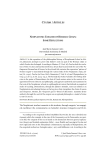
Neoplatonic Exegesis of Hermaic Chain: Some Reflections
Статья научная
In his exposition of the philosophical history of Neoplatonist School in Athens, Damascius attempts to prove that Isidore's soul was part of the Hermaic chain to which Proclus also belonged. According to Marinus (V. Procl. 28), Proclus had the revelation of this very fact and had learned from a dream that he possessed the soul of the Pythagorean Nicomachus of Gerasa. In the 4th and 6th centuries the expression “pattern of Hermes Logios” is transmitted through the various links of the Neoplatonic chain, Julian (Or. 7.237c), Proclus (in Parm. I.618), Damascius (V. Isid. Fr. 16) and Olympiodorus (in Gorg. 41.10.16–22; in Alc. 190.14–191.2). The formula that Aelius Aristides (Or. III.663) dedicates to the praise of Demosthenes, the best of Greek orators, arises in the context of an opposition between rhetoric and philosophy, and appears transferred and transmuted in the texts of the Neoplatonic schools to a philosophical context that defends an exegetical mode of teaching. Demosthenes, through his admirer Aristides, exerts an influence on Neoplatonism, introducing Hermes as the key piece that strengthens the chain of reason and eloquence. Hermes, the “eloquent” god or “friend of discourses”, transmits divine authority through the word of the exegete: an exceptional philosopher, a model of virtue to strive to rise to.
Бесплатно
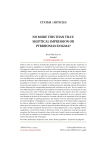
No more this than that: skeptical impression or Pyrrhonian dogma?
Статья научная
This is a defense of Pyrrhonian skepticism against the charge that the suspension of judgment based on equipollence is vitiated by the assent given to the equipollence in question. The apparent conflict has a conceptual side as well as a practical side, examined here as separate challenges with a section devoted to each. The conceptual challenge is that the skeptical transition from an equipollence of arguments to a suspension of judgment is undermined either by a logical contradiction or by an epistemic inconsistency, perhaps by both, because the determination and affirmation of equipollence is itself a judgment of sorts, one that is not suspended. The practical challenge is that, independently of any conceptual confusion or contradiction, suspending judgment in reaction to equipollence evinces doxastic commitment to equipollence, if only because human beings are not capable of making assessments requiring rational determination without believing the corresponding premises and conclusions to be true. The two analytic sections addressing these challenges are preceded by two prefatory sections, one laying out the epistemic process, the other reviewing the evidentiary context. The response from the conceptual perspective is that the suspension of judgment based on equipollence is not a reasoned conclusion adopted as the truth of the matter but a natural reaction to an impression left by the apparently equal weight of opposing arguments. The response from the practical perspective is that the acknowledgment of equipollence is not just an affirmation of the equal weight of arguments but also an admission of inability to decide, suggesting that any assent, express or implied, is thrust upon the Pyrrhonist in a state of epistemic paralysis affecting the will and the intellect on the matter being investigated. This just leaves a deep disagreement, if any, regarding whether equipollence is an inference based on discursive activity or an impression coming from passive receptivity. But this, even if resolved in favor of the critic (which it need not and ought not be), is not the same as confusion or inconsistency on the part of the Pyrrhonist, the demonstration of which is the primary aim of this paper.
Бесплатно
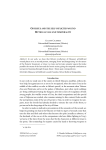
Odysseus and the self-inflicted wound mythical tale and temporality
Статья научная
In our work, we show that Helen's recollection of Odysseus' self-inflicted wound places us in an eternal present, emerging "from" and disappearing "in" the nature of the Homeric hexameter, et retour , to create and recreate semantic spaces that make possible the return of the hero and the heroic action, giving the temporal correlation an unexpected meaning through the past-future / future-past correspondence.
Бесплатно
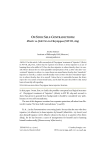
On stoic self-contradictions: vs. in Chrysippus (SVF III, 289)
Статья научная
In this article, I offer an analysis of Chrysippus’ treatment of “injustice” (ἀδικία) in SVF III, 289. First, I show that he espouses two theses: I) Every injustice is an act of harming those who suffer it; II) One who does injustice to others thereby does it to oneself. Then I discuss the two most plausible interpretations of II): a) One who does “conventional” injustice to others, i.e. causes them non-moral harm, thereby does “moralistic” injustice to oneself, i.e. makes oneself morally worse; b) One who does “moralistic” injustice to others thereby does it to oneself. I show that a) is untenable because the Stoics reject the very notion of non-moral harm, and b) fails because they believe that moral harm is basically self-regarding.
Бесплатно
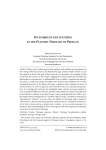
On symbolon and synthema in the platonic theology of Proclus
Статья научная
Many recent studies propose that symbolon and synthēma are synonymous in the writings of Proclus. However, his Platonic Theology contains reliable evidence to put this opinion to doubt. The goal of this research is to determine the meaning of both terms from the contexts of their usage, engaging the textual analysis and the following philosophical reconstruction. As distinguished from a symbol, a synthēma has substantial nature, is stable and remains invariable when is discovered at different levels of the ontological hierarchy. In the Platonic Theology, a symbol is often considered in terms of the hierarchic level, where it appears: in the material world, it is corporeal; among numbers, it is ontologically irrelevant, the intelligible realm contains its proper symbols as well. A significant difference between symbolon and synthēma is related to the dialectics of participation: synthēma in an object keeps it on an unparticipated level, while a symbol implies further participation to a symbolic object. Finally, a synthēma is described as “disseminated,” “planted,” or in any other way hidden in the being; while a symbol is “discovered,” or found in the being, therefore synthēma may be considered an inner kernel of what is discovered as a symbol, and a symbol - as an outward expression of a synthēma. Such understanding of these terms agrees with both exegetical and theurgic contexts in Proclus' Platonic Theology.
Бесплатно

